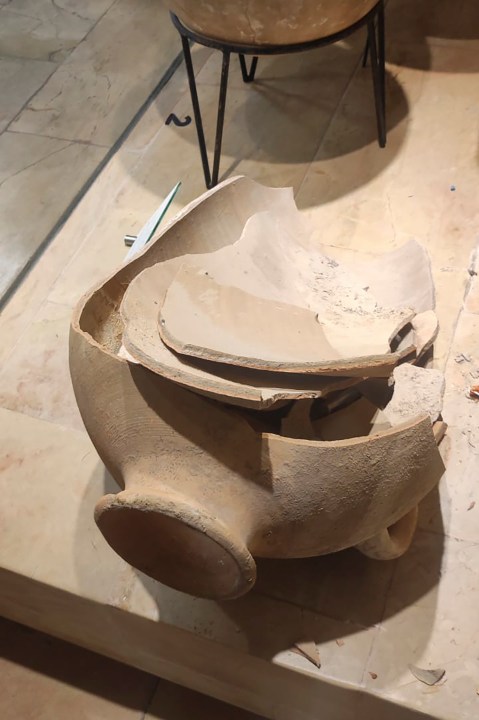HAIFA, Israel (AP) — A 4-year-old boy who accidentally broke a rare 3,500-year-old vase at an Israeli museum has been forgiven and invited back, as curators hope to learn a lesson from the tragedy.
The boy’s father, Alex Geller, said his son, the youngest of three, was extraordinarily curious and that the moment he heard the crash last Friday, the only thought that crossed his mind was: “Please don’t let this happen to my child.”
“He’s not the kind of kid who normally breaks things. He just wanted to see what was inside,” Geller told The Associated Press.

Inbar Rivlin, director of the Hecht Museum, which is affiliated with the University of Haifa in northern Israel, said the Bronze Age jar is one of many artefacts on display outdoors, part of the Hecht Museum’s vision to allow visitors to explore history without glass walls.
Rivlin said the vase was on display at the museum’s entrance, but the family left quickly without completing their visit, and she hopes to use the restoration as an educational opportunity to encourage families to return.
Geller and his family live in the northern Israeli town of Nahariya, just a few miles south of the Lebanese border, an area that has been under Hezbollah rocket attack for more than 10 months in conflict related to the Gaza war.
They spent their summer holidays visiting museums and taking day trips around Israel to escape the tensions, Geller said.
There were many children at the museum that day, and Geller said he prayed fervently that someone else was responsible for the attack. When he turned around and saw it was his son, he was “totally shocked.”
“My wife reacted faster than I did and grabbed our son, took him outside, calmed him down and explained to him that what had happened was not good,” Geller said.
He went over to the guards to let them know what had happened, hoping that it was a model and not the real thing.
“We said if we had to pay we would pay and whatever happens, we could handle it. But they called and said it was insured and invited us to come back after checking the cameras to make sure it wasn’t vandalism.”
Geller said her son didn’t quite understand the international interest over the broken bottle, but that the close-knit community in Nahariya had followed the media coverage with interest and was proud of his status as a local celebrity.
The Hecht Museum hopes to use that interest to encourage more people to visit the museum and learn about restoring artifacts.
Using 3D technology and high-resolution videos of the vase, experts plan to complete its restoration within days, and it could be put back on display as soon as next week.
“For my older kids, what’s really interesting is the process of how they’re restoring things and all the technology that’s used,” Geller said.
On display at the museum for 35 years, the jar was one of the few vessels of its size and age when it was discovered. It was likely used to hold wine or oil and was made between 2200 and 1500 BC.

Roe Shafir, a restoration expert at the museum, said that because the fragments were cut from a single, complete vase, restoration should be fairly straightforward — archaeologists often face the more difficult task of sifting through piles of fragments from multiple objects and piecing them together.
The restoration will take several days, he said, because it will use special adhesives to join the pieces together, several at a time, and the process will be documented for educational purposes.
Shafir, who says he hates puzzles but laboriously puts the jar back together, wants to keep the artifacts on public display despite the accident. He said it’s important for visitors to touch the artifacts because it could spark a deeper interest in history and archaeology.
“I like it when people interact with each other. You don’t want to destroy things, but it’s important to touch things,” he said.
Geller said her son is too young to decide if archaeology is a career, but for now he’s looking forward to visiting the museum again as a special guest on Friday and starting preschool in September.









